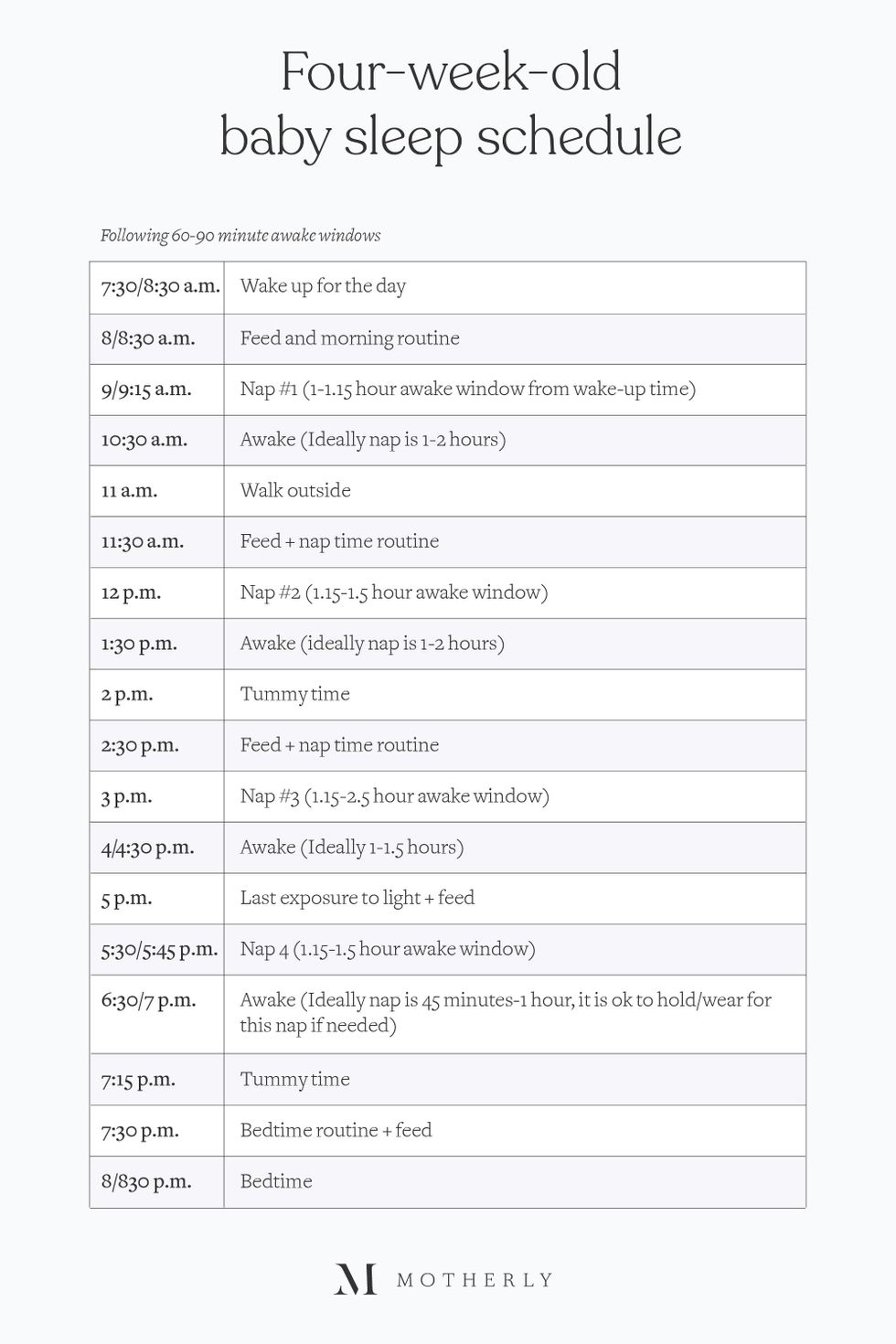How much sleep does a four-week-old baby need?
Expert guidance tips on your newborn's sleep schedule.

Can you believe your baby is four weeks old?! In the past month, there were surely some ups and downs (and tears from both of you) as you and your little one continue to adjust to your new lives. Your newborn may still not know the difference between day and night—and it’s highly unlikely they’re sleeping through the latter. (That will come later, don’t worry!) Now that you feel like you might have some sort of semblance of routine, you may be wondering how much sleep newborns need and if yours is getting enough (or too much). That’s where we come in.
To help you navigate these early weeks of infant sleep, we’ve put together a guide that includes a handy sleep schedule that illustrates how much the average four-week-old baby sleeps, plus some tips on these early days of sleeping.
Related: Baby Feeding Guides & Schedules
How much sleep does a four-week-old baby need?
Think your baby sleeps a lot? That’s a good thing! According to the American Academy of Sleep Medicine, a newborn should get 12-16 hours of sleep per 24 hours.
“At four weeks old, your baby is officially one month, which is an exciting milestone! By this time you have started to get into a routine throughout the day and before naps and bedtime. If you haven’t implemented a routine, you want to make sure you start one as soon as possible,” says Rachel Mitchell, founder of My Sweet Sleeper. “At this stage, you’ve likely noticed that your baby is much more alert than they were at week 1, and thus their naps may start to feel a little more consistent, although they will still change from day-to-day. It is recommended for your baby to be taking between 4-5 naps per day which will continue to vary in length. You can continue to hold for one or two naps of the day if needed and attempt at least 2 naps in the crib/bassinet. If you do need to hold for a nap try to do this for the 2nd and 4th nap of the day as these are usually the most difficult for your baby.”
Related: One-month-old baby milestones
This amount of sleep might have been welcome during the first few weeks, but now you may be wondering how you’ll get anything done with your baby when they’re sleeping most of the day. We’ve put together a sample sleep schedule so you can see what one 24-hour period typically looks like with a four-week-old. (Note: this is meant to be a rough guide, not a sleep schedule to attempt to put your baby on.)

“If you are wondering if you can follow a schedule yet, it is not quite time! In fact, you have quite a while until you can follow a by-the-clock schedule with your baby. However, you can definitely have a schedule in mind that you are working off of, just remember it will still change from day to day so don’t worry if it still feels very inconsistent-that is normal and expected!” says Mitchell.
Wake windows for a four-week-old
If you’re unfamiliar with the term “wake window,” don’t worry — with time it’ll become a constant phrase in your vocabulary. A wake window is the period of time an infant can stay awake in between naps without getting overtired. Since newborn babies are unable to self-regulate their sleep patterns, it’s easier for them to become overtired instead of simply just falling asleep.
Each baby is different; however, most newborns can’t stay awake longer than 45 minutes, and the average wake window for a four-week-old baby is 30 minutes. During this time, you can change their diaper, feed them, bathe them, do some tummy time, read, sing, or engage in whatever way you’d like before it’s time for them to catch some zzz’s again.
Sleep tips for newborns
Newborns make their own schedule for the most part. Developing a solid sleep schedule can take a few weeks (or longer) to take hold. You may even notice your baby gets themselves on their own regular routine after two or three weeks, and you can take their lead if it works for your family.
Your four-week-old doesn’t yet know the difference between night and day. Keeping things quiet, dim, and calm during those nighttime feedings and diaper changes can help them recognize it’s still time to sleep.
Remember, try not to keep your baby awake if they don’t want to be. An overly tired newborn can have trouble settling down and falling asleep at all, even if they’re exhausted.
- Always place your baby on their back to sleep, not on the stomach or side. This helps to reduce the risk of Sudden Infant Death Syndrome (SIDS) and Sudden Unexplained Infant Death (SUID). The American Academy of Pediatrics initiated the “Back to Sleep” movement in 1992, and rates of SIDS/SUID have decreased dramatically since.
- Do not put anything else in the crib or bassinet. Keep plush toys, pillows, blankets, loose sheets, and bumpers out of your baby’s crib or bassinet for similar reasons as above.
- Avoid overheating. Even though they’re itty-bitty babies, you can dress them according to the room’s temperature. Don’t over-swaddle or over-layer their clothing.
- Try a pacifier. If they reject it, that’s OK. If it falls out, that’s OK. If you’re breastfeeding, you may want to wait until baby is comfortable with latching and effectively nursing before introducing a pacifier.
- Use a white noise machine. Whether your house is quiet as a mouse, or you’ve got other kids running around making noise, a white noise machine can help your baby feel soothed (and possibly tune out) in their surroundings.
- Snuggle it up. Your newborn wants your cuddles as much as you want to give them—especially if they’re fussy. Swaddle them up snugly, then rock them until they quiet down. There’s no such thing as holding a newborn too much (for safety reasons, don’t fall asleep with them in your arms).
A version of this story was published August 24, 2021. It has been updated.


